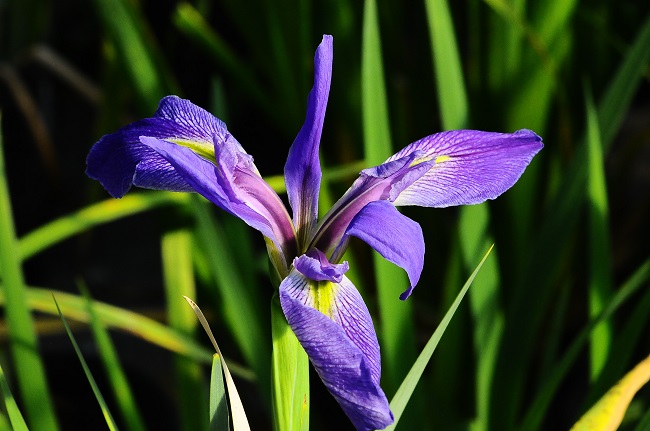Iris Blue Flag is a native aquatic perennial that grows 2 to 3 feet in height. The narrow sword-shaped leaves are pointed and flattened so they appear to form an overlapping fan. blue flag flowers from May through June with distinctive large, showy light to deep blue flowers that borne 2 to 3 to a stem. Blue flag will add a long season of elegance to your garden or water feature because in bloom they are extravagant. This plant is extremely tolerant of a wide range of cultural conditions. It can grow in the wettest or driest part of your garden. Established plants are drought tolerant and require little maintenance and can be grown in full to partial sun.

It can fit nicely into a low-maintenance landscaping plan. Given the right growing conditions—primarily sunshine, moisture, and rich soil—it should not require much care on your part.
Because it is a wetland species, northern blue flag can thrive in wet areas of your property. Use it in a rain garden as a natural way to soak up water in low-lying areas or to add interest along a pond or other water feature. Most animals, such as deer, tend to avoid eating this plant, yet its showy flowers will bring pollinators to your property. It is specifically known to attract hummingbirds.
It craves a loamy soil that is rich in organic matter. But the plant can grow in other soil types when given enough moisture.
This type of iris is considered a marginal aquatic plant, meaning it grows around the edges of water rather than in deep water. It can tolerate standing in as much as six inches of water, and it can survive being completely submerged for a short period, such as in a flood. It also can tolerate dry spells, though it prefers to remain consistently moist. Provide a shallow layer of mulch around the plant to retain moisture if necessary and give it a good watering if the soil dries out.
This plant does well in the range of conditions in USDA hardiness zones 3 to 9. It’s partial to humidity, which helps to retain soil moisture. And though blue flag readily grows in climates that experience chilly winters, a young plant can benefit from some cold-weather protection. Blanket the area around the plant for the wintertime with a layer of mulch, hay, leaves, or even just additional soil. Also, in the fall, cut back the plant to one inch above the crown—especially any diseased, dying, or dead parts—so it can more efficiently use its energy.
Blue flag likes rich soil. So, for best results, add some compost around it each spring to provide nutrition. Compost is the ideal fertilizer because it’s organic, it’s essentially free and it won’t burn your plants the way chemical fertilizers can. If you don’t have compost, this article explains how you can create great compost in only three months.
Fun Facts
Blue Flag is the official symbol of Quebec, Canada.
A similar southern wetland species, occurring from Virginia to Florida and Texas, is Southern Blueflag (I. virginica). It is a smaller plant, to 2′ tall, with bright green leaves that often lie on the ground or water.
A coastal, brackish-water species, Slender Blueflag (I. prismatica) has extremely narrow, grass-like leaves that are less than 1/4″ wide; it occurs from Maine to Georgia and Tennessee.
Related Articles & Free Email Newsletter Sign Up
Cacti are a Great Plant for Your Greenhouse
Plant Profile – Plumerias Are A Beautiful and Fragrant Tree




Comment here